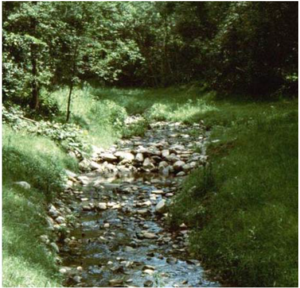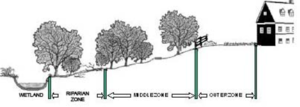
MS4 fact sheet - Vegetated Swales & Buffer Strips
For more detailed information, see the sections on swales (filtration) and vegetated filter strips for pretreatment.
Stormwater runoff from residential, commercial, industrial and agricultural land uses contains pollutants that can contaminate water bodies. Stormwater runoff from impervious surfaces also can increase runoff velocities and contribute to streambank erosion. Swales and buffer strips are a type of stormwater treatment composed of vegetation and a porous subsoil medium. Buffer strips are vegetated areas adjacent to a waterway that prohibit stormwater runoff from flowing directly into a water body.
The vegetation catches pollutants carried by stormwater, decreases the rate of flow and volume of runoff, and stabilizes the soil on the shoreline or bank, lessening erosion caused by runoff. A swale is a long, vegetated depression often used as a water conveyance system which is also designed to infiltrate water and remove sediment and pollutants from runoff. A swale, therefore, assists in recharging ground water and managing stormwater runoff quantity and quality.
This fact sheet provides guidance on the design, implementation and maintenance of vegetated swales and buffer strips and on programs to educate the public and decision makers about installing them.
Contents
Benefits / pollution reduction
Properly designed swales and buffers protect and separate a stream, lake or wetland from future disturbance or encroachment and sustain the integrity of stream ecosystem habitats. Maintaining a buffer or swale upstream of surface waters reduces pollutant impacts from sediment, phosphorus, nitrogen and high temperature waters. Additional benefits include ground water recharge, channel protection, erosion control, aquatic and terrestrial riparian habitat, flood control and recreational and educational opportunities.
Swales and buffer, when constructed properly, can remove a series of pollutants from stormwater runoff. Water quality removal rates for are variable and depend on a number of factors including slope, width, and vegetation. The Minnesota Stormwater Manual contains relevant data on pollutant removal efficiencies.
Program development and implementation
Programs designed to facilitate the installation of swales and buffers for water quality protection take into account both the mechanism of implementation and the ideal design characteristics for maximum effectiveness. For additional information on developing a buffer ordinance see the Establishing a Buffer Ordinance fact sheet. The following elements can be implemented in a vegetated swale and buffer initiative.
Awareness campaigns
Awareness campaigns inform businesses, developers, and property owners of the benefits of vegetated swales and buffers. Efforts can contribute to encouraging individuals and organizations to implement buffers on a voluntary basis, educating individuals on proper installation and maintenance. Suggested educational methods include:
- Brochures Develop informative brochures, and guidance for specific audiences such as businesses, contractors, developers, homeowners associations and garden clubs.
- Signage at municipal installations Locate signage at parks, government buildings, and parking lots identifying swales and buffers and explaining their functions and benefits.
- Workshops and seminars Workshops and seminars can be used to provide needed technical assistance to homeowners, property owners and citizens for establishing a swale or buffer on their property.
Vegetated swale design
Vegetated swales are linear, channel-like surface depressions that can be utilized as conveyance to direct stormwater away from or around a structure, for treatment to remove pollutants from stormwater, to promote infiltration of runoff into the ground and as volume control for stormwater runoff. Vegetated swales can also be landscaped to provide an aesthetic appeal and provide natural habitat within an urban setting.
Applications
- Natural drainage on a residential lot
- Along local roads in place of curb and gutter
- Parking lot islands and medians
- Highway medians
- First line of defense upstream of the stormwater system
- Aesthetic amenity at civic, commercial or residential sites
- Low flow conveyance in place of structural conveyance
- Pretreatment prior to discharge to open water or stormwater treatment facilities such as infiltration basins
Design considerations
The size of the swale including length, width, and depth is dependent upon soil conditions, ground water level, the area discharging stormwater, the amount of impervious area discharging stormwater, and the topography of the contributing area. Some design recommendations are summarized below.
- Size the bottom width, depth, length, and slope necessary to store the water quality volume with less than 18 inches of ponding at the downstream end
- Slope should not exceed 5 percent (1 to 2 percent recommended)
- Bottom width should range from 2 to 8 feet
- Ensure that side slopes are no greater than 3:1 (4:1 recommended)
- The maximum drainage area should be five acres with a maximum site slope of 20 percent
- Swales are designed to meet a runoff velocity target for a water quality storm as well as the peak discharge from a 2-year design storm. The runoff velocity should not exceed one foot-per-second during the water quality storm.
- Swales can be designed to pass larger storms and serve as conveyance tools
- Pre-treatment can be created by placing checkdams across the channel below pipe inflows, and at various other points along the channel
- Provide a 30-inch deep filter bed of amended soil in the swale if check dams are used to promote infiltration
- The swale’s ability to infiltrate is dependant upon the soils. In addition a swale will not function optimally in an area where the ground water table meets the bottom of the swale. Soils and ground water table level should be evaluated before installation. Provide a minimum 3-foot depth to bedrock or the seasonally high water table.
Vegetation
Vegetation can range from tall plants and grasses to a short turf grass depending upon the desired application of the swale. Any vegetation used should be water tolerant. Native vegetation is preferred with its ability to uptake water and filter pollutants like phosphorus and sediment. Roots of native vegetation grow deep to stabilize the soil and promote infiltration, and native vegetation does not require irrigation after the first year of establishment.
Buffer design
Review of a cross section of peer-reviewed studies identifies the following buffer characteristics that are most effective at filtering runoff and treating stormwater.
- Width The determination of buffer widths on individual wetlands could be based on the following minimum guidelines:
- 50 feet for reduction of human impact
- 50 to 100 feet for overall water quality protection
- 50 to 200 feet for habitat protection and species diversity
- Use the high end of the range for sensitive water bodies, steep slopes and surrounding land uses that could adversely impact the water body. Add buffer width to off-set the adverse impacts of slope, poor soils, human land use pressures, or to add extra protection for sensitive aquatic organisms or wildlife. Flexibility in application of buffer width requirements can be achieved through buffer width averaging, variances and conservation easements. Overall, the U.S. Fish and Wildlife Service, the MNDNR and the Center for Watershed Protection agree that bigger is better in terms of many factors including water quality treatment, erosion control and habitat.
- Vegetation A vegetative mix of trees, shrubs and groundcover are recommended to provide several layers of protection. Consider native prairie planting for the groundcover portion of any buffer. The deep roots, hardiness, aesthetic appeal, unique habitat character and filtering ability all make prairies an ideal vegetative ecosystem for a conservation buffer. Trees and shrubs can also be used as a vegetative transition from the water body. Trees and shrubs can provide for enhanced infiltration and nutrient uptake while stabilizing soil and dissipating rainfall. Specific plantings will depend upon your application and area within the state. Take care to assure that vegetation and grading of any buffer area enables runoff to occur as sheet flow rather than forming channels and rills.
- Structure The Center for Watershed Protection recommends designing a structure that includes the following elements:
- The outer zone should provide a stormwater depression area designed to capture storm runoff from small storm events
- Runoff from larger storm events should overflow the depression and spread across a grass filter designed for sheet flow and infiltration referred to as the middle zone
- The grass filter should discharge into a wider forest buffer designed to infiltrate and treat remaining runoff, the riparian zone
Maintenance considerations
Maintenance is essential to ensure a swale functions properly over time. Maintenance suggestions include:
- Regular mowing of grass swales
- Removal of garbage, debris, and dead plant material at least once a year
- Regularly inspect for erosion and proper infiltration.
- Remove sediment build-up as needed
- Replace any damaged or dead plants as needed
Typical buffer maintenance activities include:
- Remediation of any channelization that may develop
- Removal of accumulated pollutants or trash
- Weed control or other tasks to maintain healthy vegetation
- Aeration or other mitigation to maintain the high pervious quality of the soil
Typical cost
The cost of installation of a vegetated swale or buffer strip varies greatly based on width, soil amendments, the use of check dams and vegetation. The cost of the installation of a vegetated swale is estimated at $0.50 per square foot, according to a 2004 study done by the Army Corps of Engineers. There will also be costs associated with labor and supplies for necessary maintenance. Financial help may be available through cost share programs and grants to offset the cost of installation.
This page was last edited on 22 November 2022, at 18:36.


